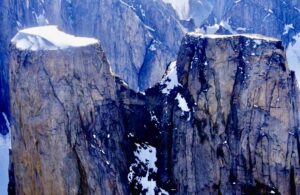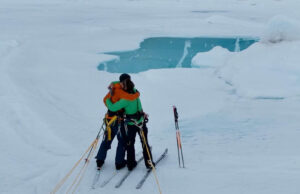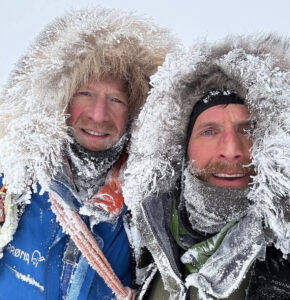On May 31, 2022, Anthony Mallinson and Lindsay Barnett began a colossal undertaking. The pair paddled from Great Slave Lake in Canada’s Northwest Territories, striking north up the Mackenzie River as far as Tuktoyaktuk. From there, they headed into the Northwest Passage.

Six weeks of food, camping, paddling gear, first aid, non-lethal bear deterrents, camera, and clothing. Photo: Coastal Mountaineering
A slow start on Great Slave Lake
The couple both have jobs tied to Canada’s wilderness. Mallinson is a wilderness guide, and Barnett works with the Invasive Species Council of British Columbia. However, the Far North was new to them.
“I was inspired largely by Victoria Jason’s account and Jonathan Waterman’s book [Arctic Crossing] even before I began paddling, and a similar trip has been the goal since,” Mallinson explained.
Early on, conditions were tough. Water levels on Great Slave Lake were high, making camping tough, and ice slowed their progress to Fort Providence. They anticipated three days for this stage of the journey, but the ice stretched this out to eight. After days of camping in what they christened ‘the swamp,’ it was a relief to get going on the broad upper reaches of the river.

Ice and high water levels made their journey on Great Slave Lake tough. Photo: Coastal Mountaineering
The gateway to the Northwest Passage
They took 45 days to reach Tuktoyaktuk on the northern coast, the gateway to the Northwest Passage. Along the way, they stopped in many communities. They took time to explore and hike, climbing Mount Hamar, Bear Rock, “and as many pingos and bumps named by early explorers as we could,” Mallinson wrote.
Continuing their journey east, almost immediately they got their first taste of an arctic storm. They ended up waiting in town for a week for the sea ice to move off the peninsula, only setting off again on July 19.

Their 2022 route. Photo: Coastal Mountaineering
“Just 25km out of town we encountered our first polar bear. Over the next 25 days, we saw no people, planes, or boats as we traveled to Paulatuk,” they said. Though they encountered no people, there was plenty of life. Beluga, caribou, and grizzlies were near-daily encounters, and the scenery left them awestruck.
But they progressed slower than they expected, with constant headwinds. Running low on energy, they decided to portage the Parry Peninsula, subbing eight days of paddling for two days of hauling. After consulting with locals, and taking into account their own frazzled state, they elected to end their summer expedition in Paulatuk.
“It was a great, humbling experience,” said Mallinson.

Camping on Round Island. Photo: Coastal Mountaineering
Stage one of a hugely ambitious project
Their 2022 paddle, clocking in at 1,800km along the Mackenzie and 655km along the coast into the Northwest Passage, is just the first stage of a grand, ambitious trip. Their end point is still just a “vague idea, it seems so far off, we’re just trying to take it one year at a time,” Mallinson explains.
If everything goes to plan, they’ll return to Paulatuk this year. From there, over a few summers, they will continue to paddle the Northwest Passage and then follow the west coast of Baffin Island down before crossing over to the mainland and finishing in Quebec City.






